MARDI HIMAL AND BABU
Popcorn at 4500 meters
The morning sky was heavy with clouds and the promise of rain as Babu and I set out from Pokhara. For the next five days, Babu, my Nepali guide and I, would be walking across the cultivated valleys and glacial terrain of the Himalayas in pursuit of Mardi Himal Base Camp, a lesser known peak in the Annapurna region that can be completed in 4-7 days depending on route and pace.
As we depart the teahouse at the start of the hike, Babu and I descend into the forest alongside a handful of other trekkers. We pass villages dotted with farms, houses, and grazing cows. We follow the trail up and down through gloomy cloud forest thick with fog and under tangles of branches draped with moss. Eventually we find ourselves walking through bamboo forest beneath an overcast sky. After a cold and windy lunch at the first rest stop, Babu and I leave most of the trekkers behind as we carry on for the day.
By early evening, after about eight hours of hiking, we reach Forest Camp, which is our resting grounds for the night. I huddle around a small wood-burning stove in the common room with other cold and tired hikers. The menu is the same at every tea house: potatoes, pasta, noodle soup, momos. “The food gets worse the higher we go,” Babu jokes. To help combat the carb overload, he presents me with a plate of ornately arranged apples, bananas, and pomegranate seeds he carried up the mountain.
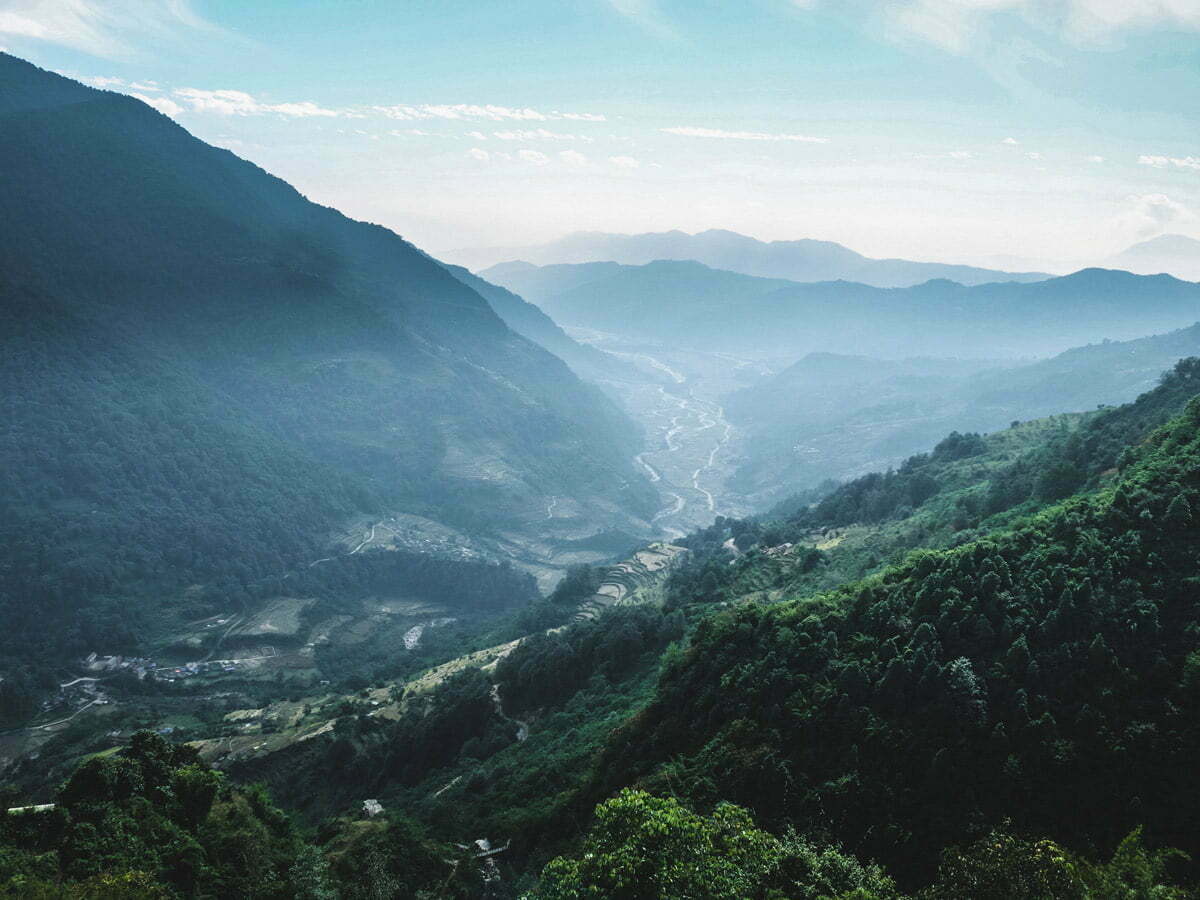
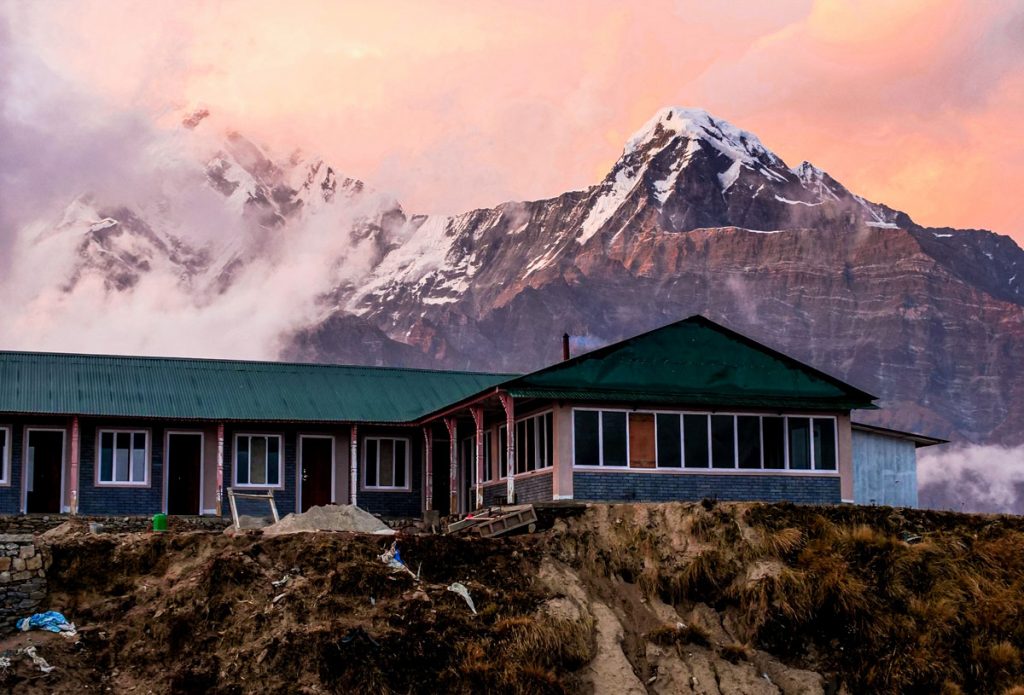
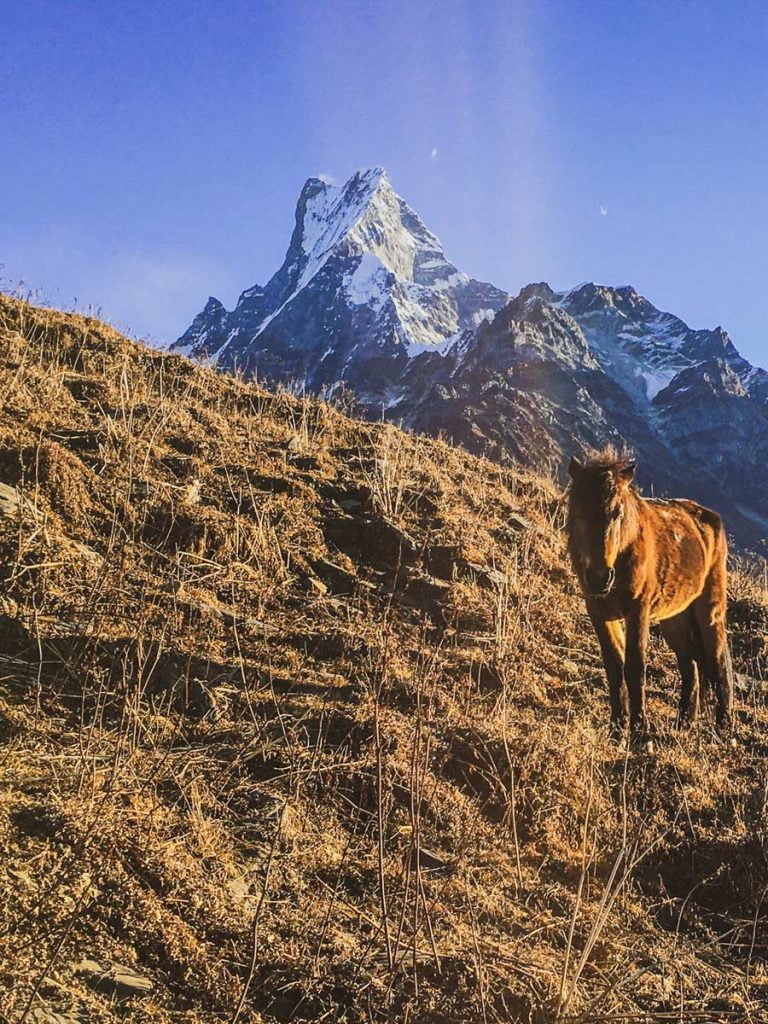
Over the next couple of days, I fall into a rhythm, enjoying the simplicity of walking deeper into the Annapurna range and delighting in the details of the ever-changing surroundings: the echoes of birds’ songs; the damp smell of soggy, forest floor thick with fallen leaves squished down by rainfall and passersby. The trails are quiet aside from the occasional worker on the mountain porting timber, water tanks, and other objects of enormous size up precarious mountain paths.
Babu tells me stories of growing up in a rural Mongolian village in Nepal, of coming to Pokhara for work, and the past decade working as a guide. His work has taken him to trails and peaks across Nepal, his love for the Himalayas evidenced by gestures such as picking up any piece of trash left on the trails. I am amazed at the strength and endurance he exudes, concealed by his slight stature, while his quiet encouragement and calm disposition make for the ideal travel companion.
By late afternoon on the second day, the shaded forest opens up into expansive vistas where jagged, snowy peaks rise from the sky. We reach High Camp, where we will sleep before making the climb to Base Camp early the following morning. Even in the bright afternoon sun, the temperatures are below freezing. I sit wrapped in my thick scarf and watch the clouds encircle the crest of the mountains until they are tinted pale pink with sunset and the wind has numbed my nose.
I retreat to the stark tea house and huddle around the fire with a handful of trekkers and Nepalese working in the mountains. The round, no-nonsense woman whose cheeks have been tinted rosy pink from months passed in the chilled air, serves me a bowl of extraordinarily spicy noodle soup. Tears run down my face, which turns as red as the soup. At 3,580m, I feel the acute fatigue and fuzziness of the mind and retire early, first stopping to marvel at the clarity of the night sky, ablaze with the twinkle of innumerable stars.
After a few hours of deep sleep interrupted by vivid altitude-induced dreams, Babu and I set out in the middle of the night beneath the liquid black sky. Babu leads the way up the rocky and precarious cliff. I carefully step one foot in front of the other, guided by the dim light of my headlamp. Only six miles and 1,000m elevation gain to go until Base Camp, which sits at a soaring 4,500m.
Babu timed our departure so we could watch the sun rise from the perfect spot. The sun swiftly rises above the horizon, revealing the great expanse of the ridges surrounding us. With each step, we draw closer to dozens of peaks over 6,000 and 7,000 meters high. We walk across a golden grassy plateau wrapped in a tangle of blue sky and clouds, hugging the snowy hips of the Himalayas.

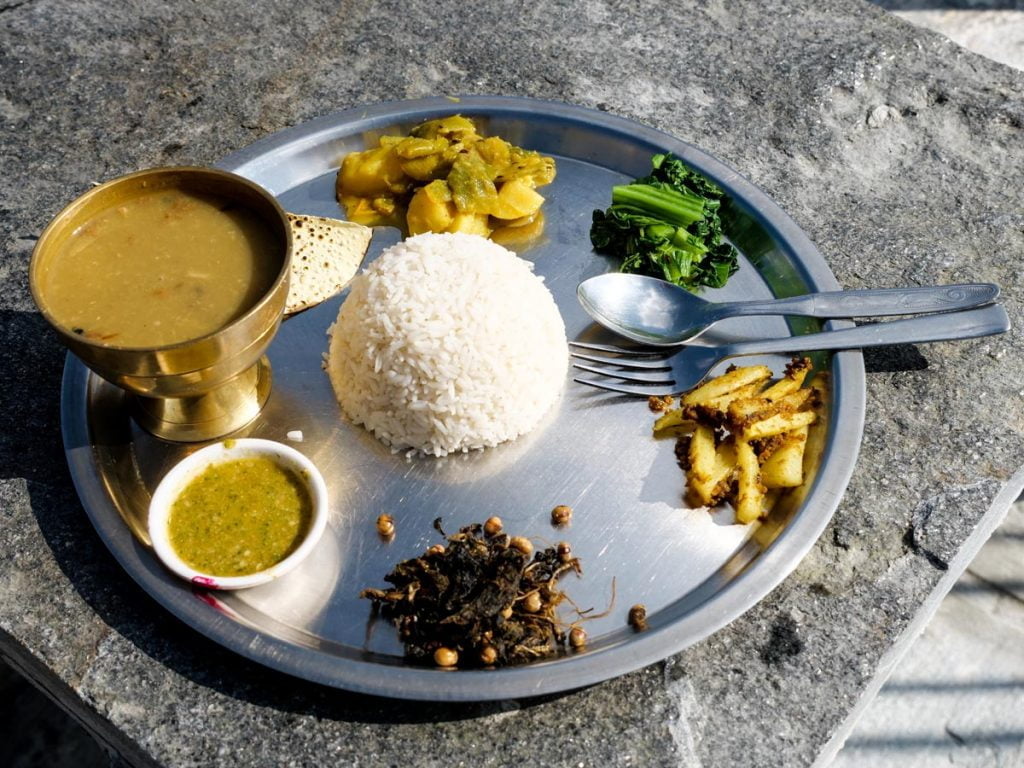
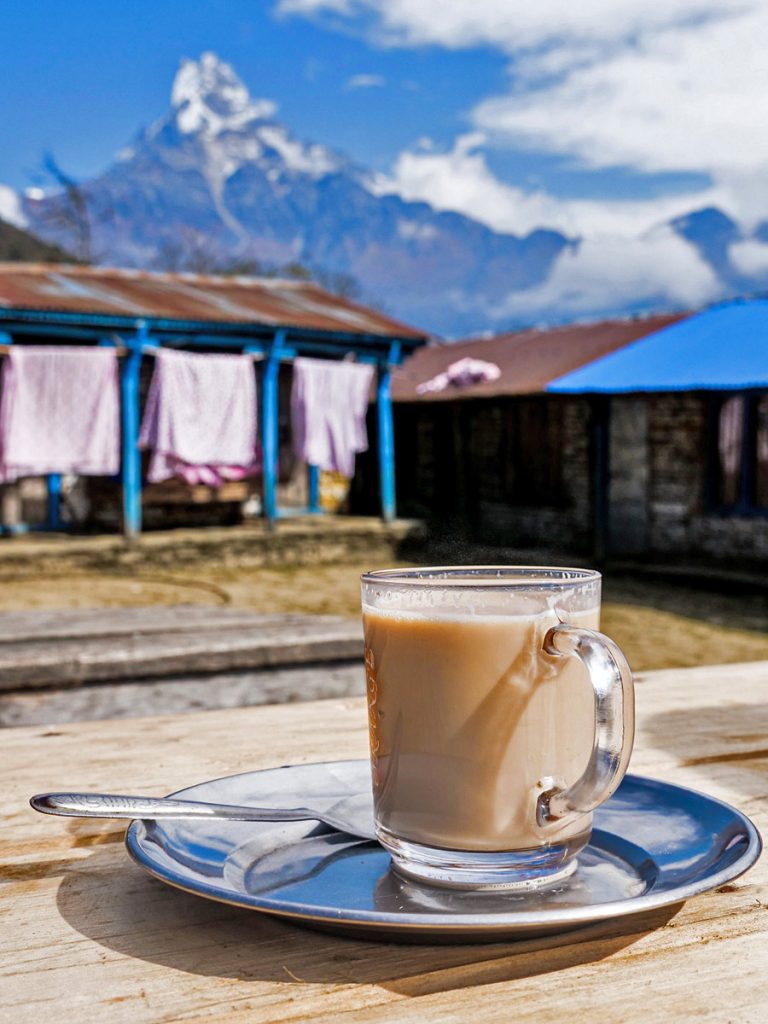
Once we reach the resting point between High Camp and Base Camp, I huddle inside an open-air shack to hide from the numbingly cold wind. Two men are cooking popcorn over the fire. Their faces, tanned and leathered, are evidence of long seasons spent working on the mountain. I clutch a hot cup of milk chai, allowing the steam to thaw my face as the hot liquid slowly warms me from the inside out.
With just one final stretch before Base Camp, Babu and I continue. Each step is more grueling than the last as the air becomes thinner with each meter climbed. Babu is seemingly unphased by the sub-freezing temperatures and altitude.
“We are getting close!” Babu announces, motivating me to trudge ahead. We walk along the backbone of the Himalayas, down into grassy gorges and up precipitous trails set against icy blue silhouettes stacked into the horizon. Before long, we come face-to-face with staggering white peaks thick with layers of ice and snow. At the top, colorful prayer flags flap in the wind, marking Mardi Himal Base Camp, 4,5000m high.

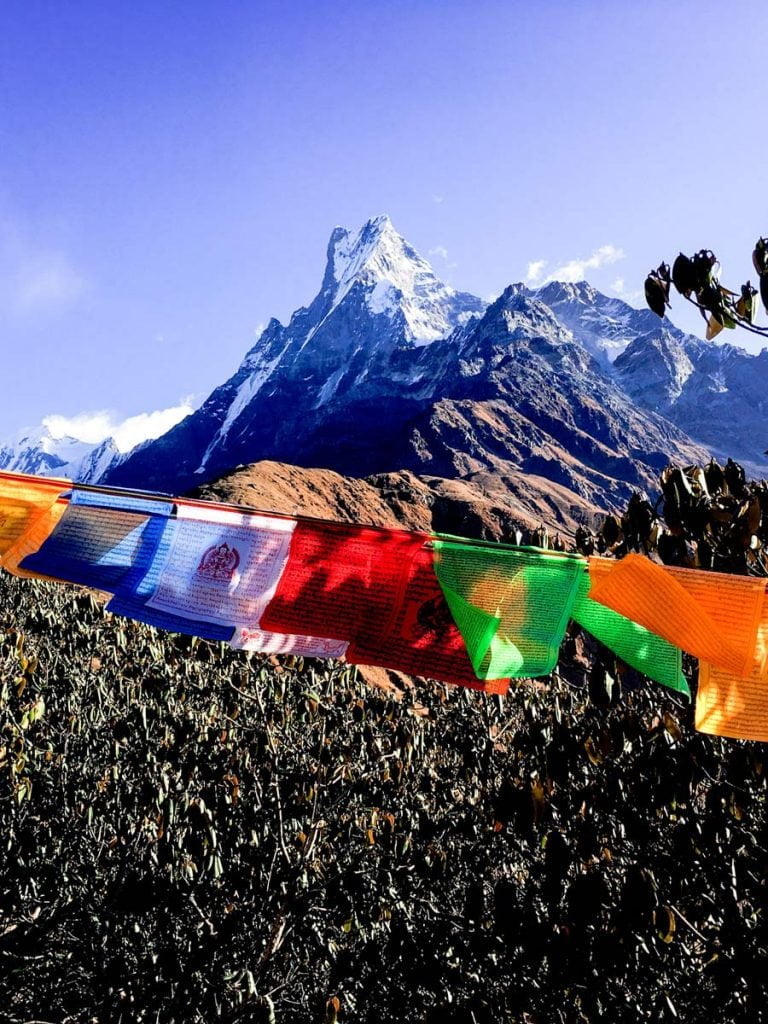
While the wind is astonishingly cold, I am hot from the morning’s journey, and peel off my top layers. Only a few other trekkers are at the top, leaving me in solitude to soak up the serenity and the silence that echoes across the sloped plateau. I walk towards the edge, looking up at sculpted grey contours and snow-covered crevices of Mardi Himal and the Annapurna range, and down into a bed of clouds. I could stay up here forever, enamored by the magnificent breadth of the Himalayas. It feels anti-climactic to turn around and leave so suddenly, heading back into the hills from which we have come.
As we leave the glacial ridgelines behind us, we head back into the forest and walk several hours down through thick forest and across rocky creeks to reach Low Camp, our cold and damp resting spot for the night.
After a full night’s rest to make up for limited sleep and 12 hours of hiking the previous day, Babu and I set out for Ghachack, a village sitting at 1825m. Some hours of walking later, I hear not-so-distant bells ringing. I run through the shadowy woods and into sun-soaked grass fields where I find yaks grazing. The bells around their necks clank against their coats of chestnut and ebony fur.
Before too long, we reach Mardi Himal Ecovillage, a simple and clean teahouse, where Babu and I are the only guests for the night. Feeling like a new person after my first shower of the trek, I sit on the expansive veranda overlooking valleys of farmland below, with views of Mardi Himal behind me. I stretch my sore muscles and relax beneath the warmth of the sun while the joyful shrieks of the owners’ young boy ring in the background. Come afternoon, I wander through fields of sloped crops, where I encounter yak herds and women farming the fields.
For dinner, I tuck into a tasty meal of homemade dal bhat, a Nepalese staple of rice, dal, and various other curries and pickled vegetables cooked by the young mother and head of the guesthouse. Babu refused to let me eat dal bhat anywhere else on the trek, claiming that only here, on our final night, it was worthy enough to try. My palate certainly couldn’t argue with his proclamation as I savor the meal’s rich spices.
In the morning we walk our final few miles. Compared to the previous days, the final stretch is an all-too-short, somewhat anti-climactic descent. Babu and I leave the green mountains behind and walk across dusty, barren terrain. Rather than being exhausted from the previous days of hiking, I am energized and eager to roam more land dotted with Mongolian villages and scale grander peaks. Over the past five days, I came to deeply appreciate exploring by foot, allowing a slower and more intimate connection to the nature and people along the way.
Want to Go?
When?
The best time to hike the Mardi Himal is either the March to May period (pre-monsoon) or the September to November period (post-monsoon). For the most stable weather, the September to November period is best, though it can get very cold later in the year.
How many Days?
The Mardi Himal can be done in about 8 days.
Experience?
No hiking experience is needed but you will feel the effects of altitude so please keep that in mind. Walking slowly is the name of the game.
Getting There
The Mardi Himal starts and ends in Pokhara
Support
Like all our trip, you will be supported by one of our guides and a porter team. We have a 1 trekker 1 porter rule, so that our team does not carry too much weight.
More Information
For more information go to our Nepal page to see all our expeditions in and around the Annapurna range.


